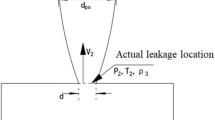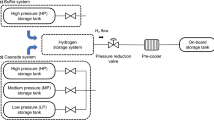Abstract
As the infrastructure to provide hydrogen for hydrogen fuel cell vehicles, hydrogen refueling station is a very important part of hydrogen energy utilization. However, due to the characteristics of hydrogen, such as flammability and explosion, low density, wide range of explosive limit concentration, hydrogen refueling station accidents often occur. The existing research on hydrogen refueling stations often uses the method of numerical simulation, and mainly considers the leakage of hydrogen storage tank. There are few relevant experimental studies and little consideration is given to the case of hydrogen pipeline leakage. In order to explore the phenomenon and rule of high-pressure hydrogen leakage and diffusion in the pipeline of hydrogen refueling stations, a full-size high-pressure hydrogen leakage test facility is built based on a real hydrogen refueling station. The vehicle-mounted high-pressure hydrogen storage tank is used as the high-pressure hydrogen gas source to provide constant hydrogen pressure to the test section through the combination of different valves in the pipeline and the instrument control system. By changing different leakage sizes and pressures, the concentration distribution and influence factors after hydrogen leakage are analyzed, which provides an important basis for the optimal layout and operation and maintenance of the safety facilities of the existing hydrogen refueling station.
You have full access to this open access chapter, Download conference paper PDF
Similar content being viewed by others
Keywords
1 Introduction
Hydrogen refueling station as the infrastructure to provide hydrogen for hydrogen fuel cell vehicles, hydrogen refueling station is a very important part of hydrogen energy utilization. However, due to the characteristics of hydrogen, such as flammability and explosion, low density, wide range of explosive limit concentration, hydrogen refueling station accidents often occur. The existing research on hydrogen refueling stations often uses the method of numerical simulation, and mainly considers the leakage of hydrogen storage tank. There are few relevant experimental studies and little consideration is given to the case of hydrogen pipeline leakage. In order to explore the phenomenon and rule of high-pressure hydrogen leakage and diffusion in the pipeline of hydrogen refueling stations, a full-size high-pressure hydrogen leakage test facility is built based on a real hydrogen refueling station. The vehicle-mounted high-pressure hydrogen storage tank is used as the high-pressure hydrogen gas source to provide constant hydrogen pressure to the test section through the combination of different valves in the pipeline and the instrument control system. By changing different leakage sizes and pressures, the concentration distribution and influence factors after hydrogen leakage are analyzed, which provides an important basis for the optimal layout and operation and maintenance of the safety facilities of the existing hydrogen refueling station.
2 Experimental System
2.1 Experimental System Design
Based on the design of pipelines and valves for typical hydrogen energy facilities and equipment, a high-pressure hydrogen storage tank (with a pressure more than 35 MPa) is used as the high-pressure hydrogen gas source. through the combination of different valves in the pipeline and the instrument control system, a constant hydrogen pressure is provided to the pipeline in the test section, and a high-pressure hydrogen gas leakage diffusion test facility is built.
Using hydrogen concentration sensors, sound sensors, fiber optic sensors, and infrared sensors to monitor the diffusion behavior of hydrogen after high-pressure leakage, analyze the flow field structure and concentration spatiotemporal distribution of hydrogen under different leakage pressures and leakage ports, analyze the diffusion behavior, acceleration, and changes in hydrogen leakage vibration measured by sound sensors, and comprehensively analyze the impact of different fracture sizes on hydrogen diffusion behavior, Provide data support for the hydrogen leakage diffusion dynamics model and the prediction method of combustion and explosion risk areas.
2.2 Test Facility
The high pressure hydrogen leakage test facility is shown in Fig. 1.
The system mainly consists of a gas supply system, a pressurization system, a test section, and a relief system. Vibration sensors are arranged on the test section, sound sensors are arranged near the leakage port, and several hydrogen concentration sensors are arranged above the leakage port to monitor the leakage behavior of hydrogen. The actual test facility is shown in Fig. 2.
The experimental system is equipped with two leakage nozzles with diameters of 0.05 and 1 mm. The nozzle can be horizontal and vertical. The hydrogen booster can pressurize the hydrogen gas to a maximum of 35 MPa. The input parameters of this experimental system mainly refer to the relevant parameters of the actual demonstration hydrogen refueling station, as is shown in Table 1.
The material of the test section pipeline is Q345 or 316 L seamless steel pipe, and the maximum size of simulated leakage in the test section is the inner diameter of the pipeline. According to the actual operation of a hydrogen refueling station, the pipeline size is 3/4 inch, with an outer diameter of 19.05 mm, which corresponds to an inner diameter of 10.97 mm (0.432 in) at a working pressure of 35 MPa.
3 Test Results
3.1 Horizontal Hydrogen Ejection Condition
Horizontal hydrogen ejection condition is shown in Fig. 3. Three sensors were arrange at a distance of 1m downstream of the nozzle, the lower sensor is located directly in front of the nozzle, and the distance between the upper two sensors is 50 cm. The pressure at the nozzle is 52 bars. Within 2 s after the start of hydrogen injection, the hydrogen sensor measures the hydrogen concentration value. The hydrogen sensor facing the nozzle measures the maximum value, and the middle hydrogen sensor delays for 1 s to measure the hydrogen concentration data. The top hydrogen sensor hardly measures the hydrogen gas data. When the hydrogen injection ends, the wake concentration is measured to be about 1%.
3.2 Vertical Hydrogen Ejection Condition
Vertical hydrogen ejection condition is shown in Fig. 4. Three sensors are arranged. The middle sensor is located directly above the nozzle, and the distance between the sensors on both sides is 70 cm from the middle sensor. The pressure at the nozzle is 42 bars. Within 2.5 s after the hydrogen gas is sprayed, the hydrogen sensor measures the hydrogen concentration value, while the middle hydrogen sensor measures the maximum value. The two symmetrically arranged side sensors measure a smaller value, and the maximum hydrogen concentration values of the two are almost the same.
4 Conclusions
-
1.
Hydrogen will diffuse quickly (≤ 2 s) even under lower pressure (45 bars), sensors need to be arranged above the pipelines.
-
2.
Acceleration sensors can be used since they are not affected by wind or other factors.
-
3.
Hydrogen will not spontaneously ignite under 50 bars.
Further research need to be done such as obstacles, different nozzle shapes and higher pressures (700 bars).
References
Wang, Z.: Research challenges in high-pressure hydrogen spontaneous ignition. J. Nanjing Tech. Univ. (Nat. Sci. Edn.) 41(5), 656–663 (2019)
Astbury, G., Hawksworth, S.: Spontaneous ignition of hydrogen leaks: a review of postulated mechanisms. Int. J. Hydrogen Energy 32(13), 2178–2184 (2007)
Ekoto, I.W., Merilo, E.G., Houf, W.G., Evans, G.H., Groethe, M.A.: Experimental investigation of hydrogen release and ignition from fuel cell powered forklifts in enclosed spaces. In: 4th International Conference on Hydrogen Safety, San Francisco, CA, 12–14 Sept 2011
Hall, D.J., Walker, S.: Scaling rules for reduced-scale field releases of hydrogen fluoride. J. Hazard. Mater. 54, 89–111 (1997)
Houf, W.G., Evans, G.H., James, S.C., Merilo, E., Groethe, M.: Simulation of hydrogen releases from fuel-cell vehicles in tunnels. In: Proceedings of World Hydrogen Energy Conference, Essen, Germany, 16–21 May 2010
Houf, W.G., Evans, G.H., Ekoto, I.W., Merilo, E., Groethe, M.: Hydrogen fuel-cell forklift vehicle releases in enclosed spaces. Int. J. Hydrogen Energy
Author information
Authors and Affiliations
Corresponding author
Editor information
Editors and Affiliations
Rights and permissions
Open Access This chapter is licensed under the terms of the Creative Commons Attribution 4.0 International License (http://creativecommons.org/licenses/by/4.0/), which permits use, sharing, adaptation, distribution and reproduction in any medium or format, as long as you give appropriate credit to the original author(s) and the source, provide a link to the Creative Commons license and indicate if changes were made.
The images or other third party material in this chapter are included in the chapter's Creative Commons license, unless indicated otherwise in a credit line to the material. If material is not included in the chapter's Creative Commons license and your intended use is not permitted by statutory regulation or exceeds the permitted use, you will need to obtain permission directly from the copyright holder.
Copyright information
© 2024 The Author(s)
About this paper
Cite this paper
Jiang, B., Zhen, T., Fang, F. (2024). Experimental Research on High-Pressure Hydrogen Leakage and Diffusion of Hydrogen Refueling Station. In: Sun, H., Pei, W., Dong, Y., Yu, H., You, S. (eds) Proceedings of the 10th Hydrogen Technology Convention, Volume 1. WHTC 2023. Springer Proceedings in Physics, vol 393. Springer, Singapore. https://doi.org/10.1007/978-981-99-8631-6_22
Download citation
DOI: https://doi.org/10.1007/978-981-99-8631-6_22
Published:
Publisher Name: Springer, Singapore
Print ISBN: 978-981-99-8630-9
Online ISBN: 978-981-99-8631-6
eBook Packages: Physics and AstronomyPhysics and Astronomy (R0)








